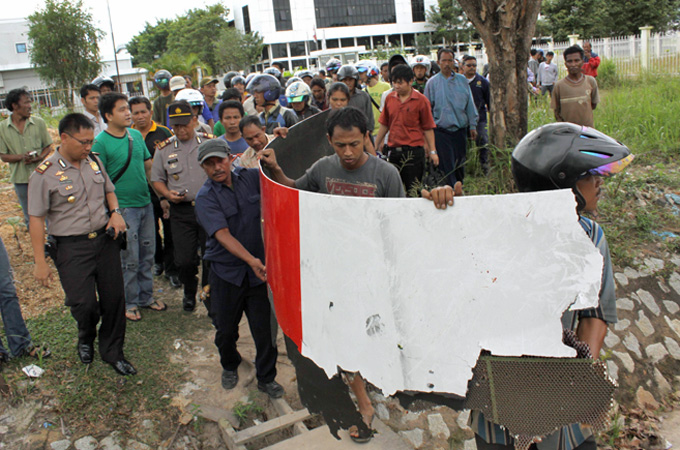Qantas grounds A380s after incident
Australia’s flagship carrier suspends all its Airbus A380s after engine failure forces plane to make emergency landing.

 |
| Residents of an Indonesian island near Singapore retrieved debris from the Airbus on Thursday [AFP] |
Australian airline Qantas has grounded flights on its Airbus A380 aeroplanes after one of its aircraft suffered an in-flight engine failure prompting it to make an emergency landing in Singapore.
The Qantas Airways A380 landed safely after running into engine trouble shortly after it had left the island state en route for Sydney.
Keep reading
list of 4 items‘Mama we’re dying’: Only able to hear her kids in Gaza in their final days
Europe pledges to boost aid to Sudan on unwelcome war anniversary
Birth, death, escape: Three women’s struggle through Sudan’s war
While no injuries were reported among the 459 people on board, the incident is one of the most serious for the world’s largest passenger plane in its three years of commercial flight.
Singapore Airlines, which operates 11 A380 aircraft, also grounded its A380 aircraft following the incident, but flights resumed early on Friday morning.
A statement on the company’s website said: “Singapore Airlines has begun resuming A380 flights following precautionary checks.”
‘Significant’ failure
Alan Joyce, Qantas chief executive, said Qantas flights would remain grounded “until we are completely confident that Qantas safety requirements have been met”.
Speaking after the incident on Thursday, he said the troubled flight had experienced a “significant” failure to one of its four engines.
Rolls-Royce, the British firm that built the aircraft’s engine, pledged to work with Qantas to identify the problem.
No injuries were reported among the 459 people on board, but the incident was one of the most serious for the world’s largest passenger plane in its three years of commercial flight.
Passengers recounted loud bangs and a fire on the super jumbo’s wing shortly after it took off.
“About five or six minutes after take-off, I heard a loud bang and I looked out of the window. I saw debris from the engine shooting through the wing outside the plane,” Ulf Waschbusch, a German passenger who was heading to Sydney on holiday, told Al Jazeera after leaving the plane.
He said the situation on the plane was “surprisingly calm”.
“People didn’t talk much, people took a lot to themselves. I have to say kudos to Qantas and the crew on board who tried to keep us calm and tried to keep us informed.
“There were actually five pilots on board from various flights so they had people who would actually walk through the aisle and talk to passengers.”
Emergency landing
Metal debris from the plane fell down in the Indonesian city of Batam, on an island just south of Singapore.
The pieces, mostly small, torn metal, but some the size of doors, were brought to police headquarters for the investigation.
|
Al Jazeera’s Tony Birtley reports from Singapore |
After the boom was heard, flight QF32’s captain announced the jet needed to dump fuel in preparation for an emergency landing. The aircraft circled Singapore airport before it landed successfully, about two hours after take-off.
The engine closest to the fuselage on the left wing had visible burn marks and was missing a plate
section that would have been painted with the red kangaroo logo of the airline.
The upper part of the left wing also appeared damaged.
Lufthansa told Al Jazeera it is flying its A380s as scheduled, despite the fact it uses the same engines as the one that failed on the Qantas flight. However, the airline said it is carrying out checks, as recommended by Rolls-Royce.
Emirates airline, the biggest A380 customer, said it had no plans to ground its 13 super jumbos which use different engines to the one that failed on Thursday.
Critical investigation
Al Jazeera’s Tony Birtley, reporting from SIngapore, said it was in everyone’s interest to conclude the investigation into the incident as soon as possible.
“But a negative result would be devastating for Airbus. Even before this problem happened, the A380 project was being described as a 24 billon dollar write-off,” he said.
There have been no fatal incidents involving A380s since they were launched in 2005 amid great fanfare as the greenest, quietest – as well as the biggest – jetliner.
Earlier this year, one of the planes operated by Qantas burst two tyres when landing in Sydney and in September 2009 an A380 was forced to turn around in mid-flight and return to Paris.
“This is probably the most serious incident involving the A380 since it began flying in commercial service,” Tom Ballantyne, chief correspondent of Orient Aviation magazine, said.
“There have been minor engine incidents before but nothing like this.”
Qantas has had a reputation of being the world’s safest airline, not suffering a fatal incident since 1951.
But a number of recent incidents have tarnished its reputation.
In August, an engine failure blasted a large hole in a Sydney-bound 747-400, forcing it to return to San Francisco.
In 2008, a mid-air explosion blew a minivan-size hole in the side of a plane of the same model. Australian air safety investigators blamed that incident on an oxygen bottle.
The A380 has been bedevilled with production delays. More than 200 orders have been placed for the aircraft, and 37 are in operation worldwide, according to Airbus.
Qantas said the latest incident did not impact its standing orders for more A380s.